Breathing techniques are quick, accessible ways to calm your mind and body during stressful moments. Alternatives like meditation, yoga, or physical activities offer longer-lasting benefits and deeper relaxation. The best method depends on your lifestyle, preferences, and stress levels. Combining these approaches often works best for sustained stress relief. If you’re curious about which strategies suit you and how to personalize them, exploring further can help you choose what truly fits your needs.
Key Takeaways
- Breathing techniques offer quick, accessible stress relief and can be practiced anytime without special equipment.
- Longer-term methods like meditation and yoga deepen relaxation and build emotional resilience over time.
- Combining breathwork with other practices enhances overall stress management and mental well-being.
- Professional therapies provide targeted support for persistent stress or anxiety beyond self-guided techniques.
- Choosing the best approach depends on your stress levels, goals, and preference for immediate relief or sustained benefits.
Understanding the Basics of Breathing Techniques
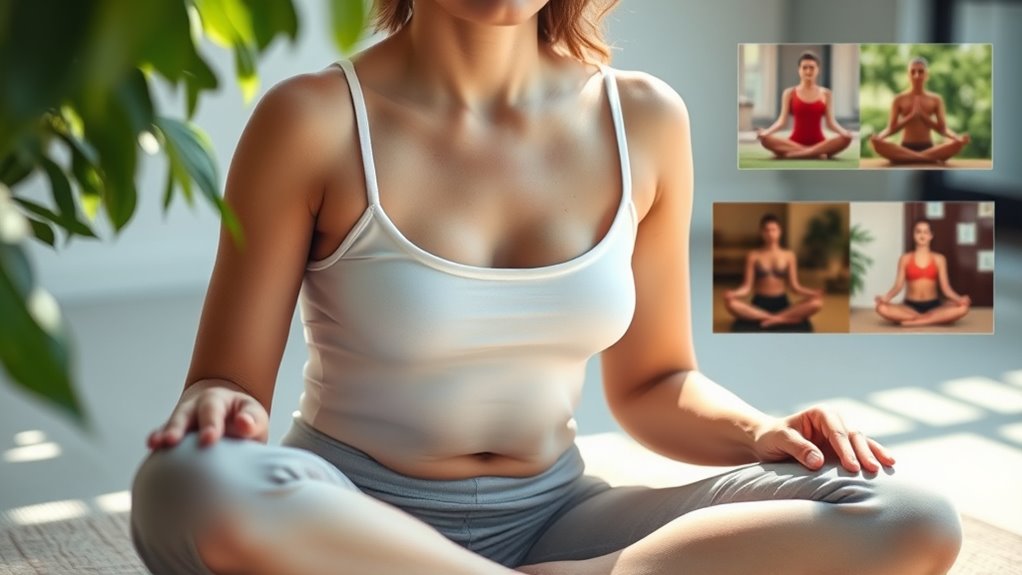
Breathing techniques are simple but powerful tools you can use to manage stress effectively. One fundamental method is diaphragmatic breathing, which involves engaging your diaphragm to deepen each breath. This technique helps you take fuller, more intentional breaths, promoting relaxation. To practice, focus on breath awareness—paying close attention to how you inhale and exhale without judgment. As you breathe deeply into your belly, you activate your body’s natural relaxation response. This simple practice can be done anytime, anywhere, and doesn’t require special equipment. Understanding stress management methods and practicing diaphragmatic breathing and breath awareness, you gain control over your stress response, making it easier to stay calm and centered during challenging moments.
The Science Behind Stress Reduction Through Breathwork

When you practice diaphragmatic breathing and increase your awareness of your breath, your body responds in measurable ways that promote relaxation. Clinical trials show that controlled breathing can lower stress biomarkers like cortisol and adrenaline, key indicators of stress levels. This physiological change isn’t just theoretical—it’s backed by science. Here’s what happens:
Controlled breathing lowers stress markers and promotes relaxation, backed by scientific research.
- Your heart rate slows, reducing feelings of anxiety.
- Blood pressure stabilizes, easing physical tension.
- Stress biomarkers decrease, signaling reduced stress response.
- Your nervous system shifts toward parasympathetic activation, promoting calmness.
- Understanding supermarket hours can help plan your routines to include stress-reducing activities more effectively.
These responses demonstrate that breathwork directly influences your body’s stress regulation, making it a scientifically supported strategy for stress reduction.
Popular Breathing Exercises and How They Work
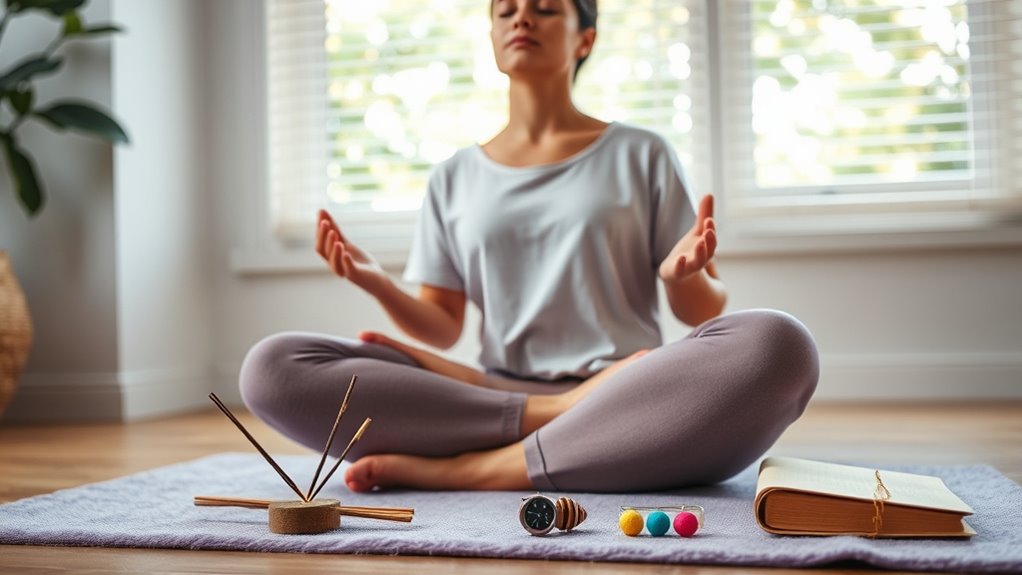
You can reduce stress effectively by practicing popular breathing exercises like deep breathing, diaphragmatic breathing, and box breathing. These techniques work by calming your nervous system and increasing oxygen flow. Understanding how each method functions helps you choose the right one for your needs. Incorporating these exercises into your lifestyle can lead to lasting stress relief and improved overall well-being.
Deep Breathing Techniques
Deep breathing techniques are simple yet powerful tools that can quickly calm your mind and body during stressful moments. By practicing mindful breathing and breath awareness, you engage your parasympathetic nervous system, reducing tension. Here are four ways these techniques make a difference:
- You focus on your breath, anchoring your mind in the present.
- You slow your breathing, lowering your heart rate and easing anxiety.
- You create a sense of control amid chaos.
- You cultivate a calming rhythm that soothes your nervous system.
- Incorporating celebrity lifestyle insights can inspire and motivate you to maintain consistent practice.
These practices help you stay centered and reduce stress quickly. As you develop breath awareness, you’ll find it easier to access a peaceful state anytime you need it. Deep breathing becomes a reliable tool to manage stress effectively.
Diaphragmatic Breathing Benefits
Diaphragmatic breathing, also known as belly breathing, offers powerful stress-relief benefits by engaging the diaphragm—a muscle located just below your lungs—more fully than shallow chest breathing. When you practice mindful breathing through diaphragmatic exercises, you activate your body’s relaxation response, reducing cortisol levels and calming your mind. By focusing on deep, intentional breaths that expand your belly, you improve oxygen flow and promote a sense of calm. These exercises help you become more aware of your breath patterns, fostering mindfulness and reducing anxiety. Regular diaphragmatic breathing can enhance overall well-being, improve sleep, and lower stress levels. Incorporating this technique into your routine makes it easier to manage daily pressures and cultivate a sense of control and relaxation. Additionally, practicing natural elements like water features or calming textures can further amplify your relaxation experience.
Box Breathing Method
The Box Breathing Method is a structured breathing technique that enhances focus and promotes calmness by maintaining a steady rhythm. It involves inhaling, holding, exhaling, and pausing, each for an equal count, fostering mindful breathing and breath awareness. This method helps you regain control during stressful moments. Additionally, exploring visual language through fan trailers demonstrates how creative communities develop innovative storytelling techniques that can inspire your practice. To experience its benefits, you can:
- Feel your stress melt away as your mind clears.
- Reconnect with your breath, anchoring you in the present.
- Improve concentration with each controlled inhale and exhale.
- Cultivate a sense of calm that stays with you throughout the day.
Exploring Other Mind-Body Practices for Stress Relief
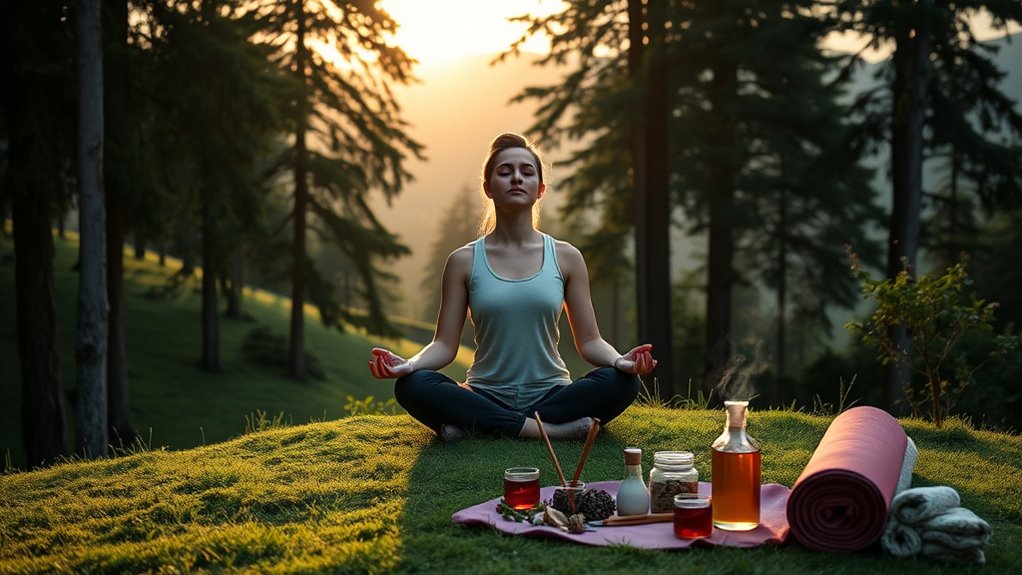
Beyond breathing exercises, you can explore practices like meditation, yoga, and progressive muscle relaxation to reduce stress. These techniques help calm your mind and relax your body, offering additional relief. Incorporating them into your routine can enhance your overall stress management. Additionally, integrating mindfulness practices can deepen your sense of relaxation and improve emotional resilience.
Meditation Techniques and Benefits
Many mind-body practices, such as meditation techniques, offer effective ways to reduce stress and promote relaxation. By practicing meditation, you can access a range of benefits:
- Experience aromatherapy benefits as calming scents enhance your meditation, deepening relaxation.
- Use journaling techniques afterward to process emotions, fostering mental clarity.
- Cultivate mindfulness that helps you stay present, reducing anxiety’s grip.
- Develop a sense of inner peace, empowering you to face daily challenges with resilience. These techniques can evoke powerful feelings of calm and control, making stress more manageable. Incorporating meditation into your routine provides a holistic approach to well-being, nourishing both mind and body. It’s a simple yet profound way to enhance your mental health and find balance amid life’s chaos.
Yoga for Stress Relief
Have you considered how practicing yoga can effectively reduce stress and promote relaxation? Yoga combines breath control with gentle movements, helping you manage stress triggers more effectively. By focusing on your breath, you learn to calm your nervous system and create a sense of peace. As you hold poses and breathe deeply, you become more aware of your body’s responses to stress, gaining tools to counteract tension. Yoga encourages mindfulness, allowing you to stay present and avoid spiraling into anxious thoughts. Regular practice can lower cortisol levels and improve overall mental health. Whether you’re a beginner or experienced, integrating yoga into your routine offers a holistic approach to managing stress naturally and mindfully.
Progressive Muscle Relaxation
Progressive Muscle Relaxation (PMR) is a simple yet effective technique that helps you release tension by tensing and then relaxing different muscle groups throughout your body. As you practice, you’ll notice a profound sense of calm wash over you. To deepen your relaxation, consider pairing PMR with mindful walking, allowing you to connect with your breath and surroundings. You might also incorporate aromatherapy blends, inhaling calming scents like lavender or chamomile to enhance your experience. Here’s how to maximize your practice: 1. Focus on each muscle group, feeling the tension build and release. 2. Use mindful walking afterward to extend your relaxation. 3. Combine PMR with soothing aromatherapy blends for added tranquility. 4. Notice how this practice reduces stress, leaving you refreshed and centered. Additionally, exploring cultural and regional breakfast traditions can provide a comforting routine that supports your mental well-being.
Physical Activities That Help Alleviate Stress
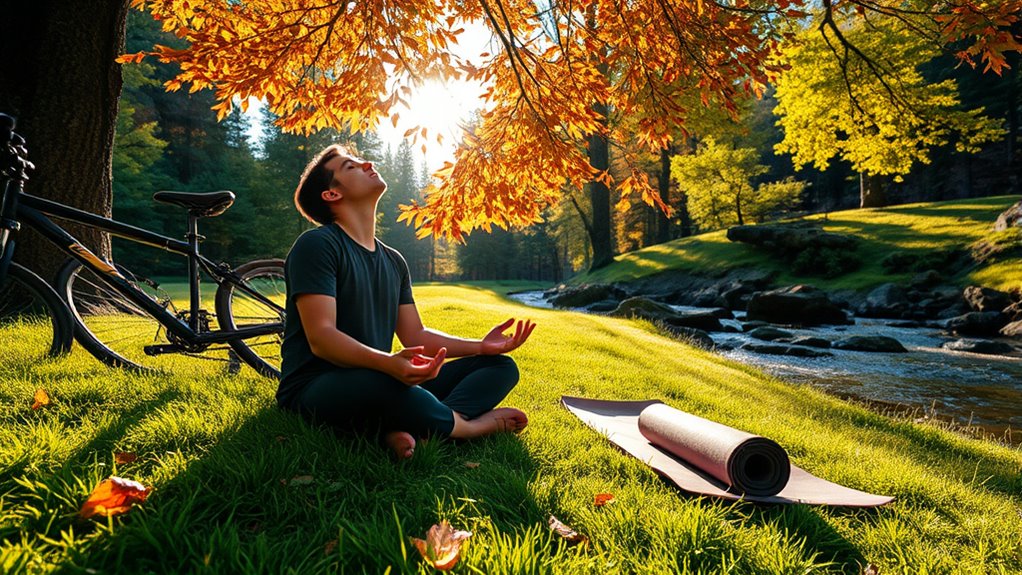
Engaging in physical activities can be a highly effective way to reduce stress, as movement releases endorphins that boost your mood and calm your mind. Activities like brisk walking, jogging, cycling, or dancing help lower cortisol levels, making you feel more relaxed and centered. Regular physical activity not only improves your physical health but also enhances your mental well-being by providing a healthy outlet for stress. Even simple exercises such as stretching or yoga can promote relaxation and increase your resilience to daily pressures. Incorporating these activities into your routine can create a powerful stress reduction strategy. Airless paint sprayers are an example of tools that can help you complete home improvement projects efficiently, reducing the stress associated with lengthy or complicated painting jobs. Remember, consistency is key—finding activities you enjoy ensures you’ll stick with them and reap the long-term benefits for your mental health.
Meditation and Mindfulness: Deepening Your Relaxation Practice
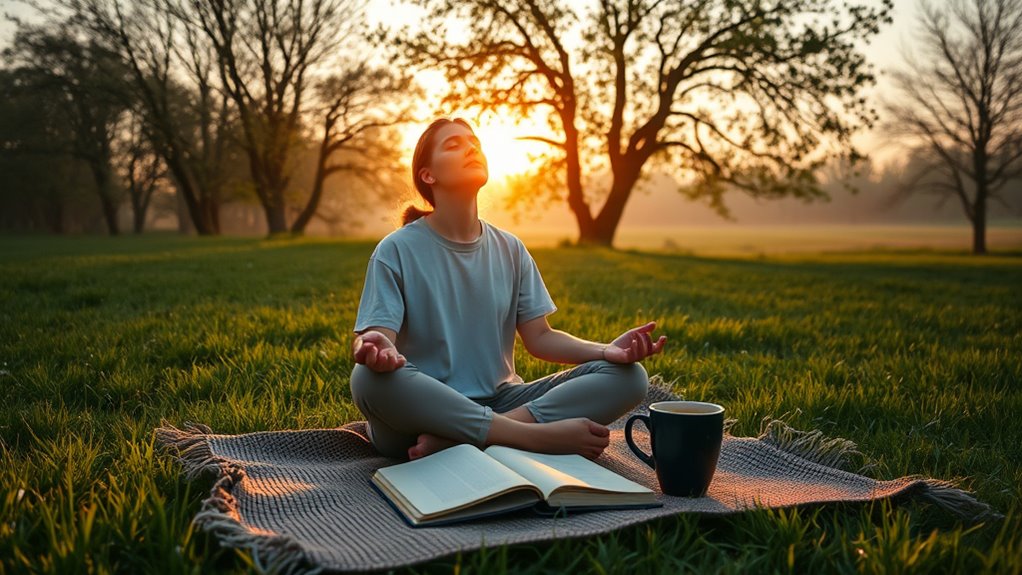
Building on the benefits of physical activity, incorporating meditation and mindfulness into your routine can deepen your relaxation and help maintain stress relief throughout the day. Focus on breathing awareness to anchor yourself in the present moment. Use relaxation techniques like body scans or guided imagery to enhance calmness. Here are four ways to deepen your practice:
Enhance relaxation by practicing daily meditation, mindful breathing, body awareness, and guided imagery.
- Commit to daily meditation sessions, even for a few minutes.
- Practice mindful breathing during stressful moments.
- Incorporate body awareness to recognize tension.
- Use guided mindfulness apps to stay consistent and focused.
- Exploring techniques like Kia Tuning can also contribute to a sense of control and relaxation in your daily life.
Professional Stress Management Therapies and When to Consider Them
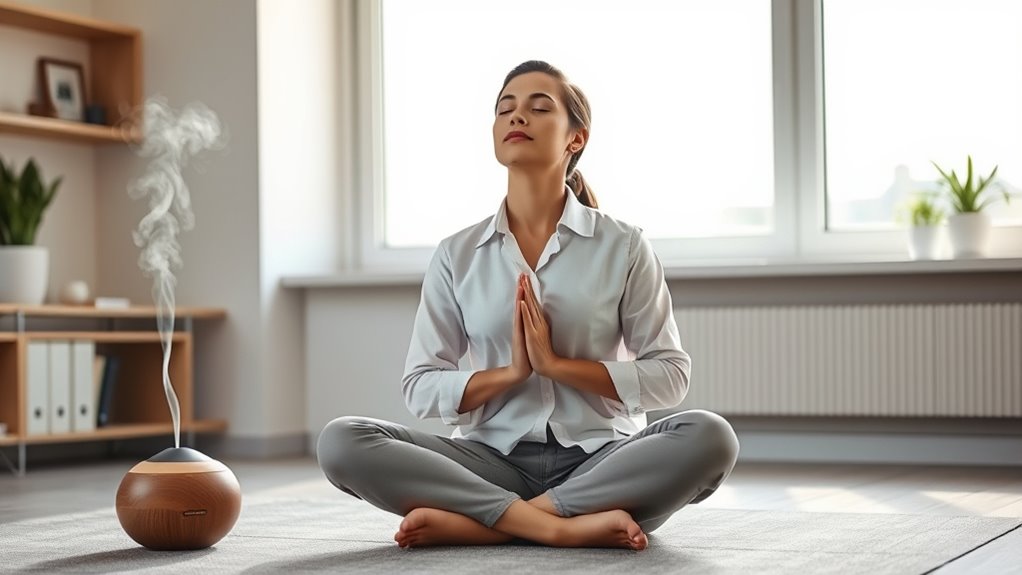
When stress becomes overwhelming, professional therapies can offer targeted support, but knowing which options are available is key. Recognize the signs that indicate it’s time to seek help and understand the benefits these therapies can provide. Exploring different types of treatment can help you find the right approach to manage stress effectively.
Types of Therapy Available
Are professional stress management therapies right for you? If you’re feeling overwhelmed, exploring options can provide relief. Consider these therapies:
- Aromatherapy relaxation, which uses essential oils to calm your mind and body.
- Art therapy, allowing you to express emotions creatively and process stress.
- Cognitive-behavioral therapy (CBT), helping change negative thought patterns.
- Mindfulness-based stress reduction (MBSR), teaching you to stay present and reduce anxiety.
These therapies can evoke a deep sense of calm and empowerment. If traditional methods aren’t enough, trying aromatherapy relaxation or art therapy might open new pathways to peace. Recognize when you need support, and don’t hesitate to seek professional guidance tailored to your needs.
Recognizing When to Seek Help
Knowing the signs that indicate you need professional help can make all the difference in managing stress effectively. If your mental health declines despite breathing exercises or social support, it’s time to contemplate therapy. Persistent feelings of hopelessness, overwhelming anxiety, or difficulty functioning daily are red flags. Recognizing these cues helps you seek appropriate support sooner. Use this table to assess your situation:
| Symptoms | When to Seek Help |
|---|---|
| Overwhelming anxiety | If it disrupts daily activities |
| Persistent sadness | When it lasts weeks without relief |
| Social withdrawal | If it affects your relationships |
If these signs resonate, talking to a mental health professional can provide targeted strategies. Remember, seeking help isn’t a sign of weakness—it’s a proactive step toward better mental health.
Benefits of Professional Support
Seeking professional support can considerably enhance your stress management efforts, especially when breathing exercises and social support aren’t enough. Professional therapies, like mindfulness journaling and guided counseling, help you uncover root causes and develop tailored strategies. Consider these signs to know when to seek help:
- You feel overwhelmed despite trying self-care techniques.
- Persistent anxiety affects your daily life.
- You’re interested in integrating nutritional supplements into your routine.
- You want structured guidance to build lasting resilience.
Therapists can teach you effective tools, such as mindfulness journaling, to process emotions, and recommend nutritional supplements to support your mental health. Reaching out isn’t a sign of weakness—it’s a proactive step toward lasting well-being.
Comparing Ease of Use and Accessibility of Different Methods
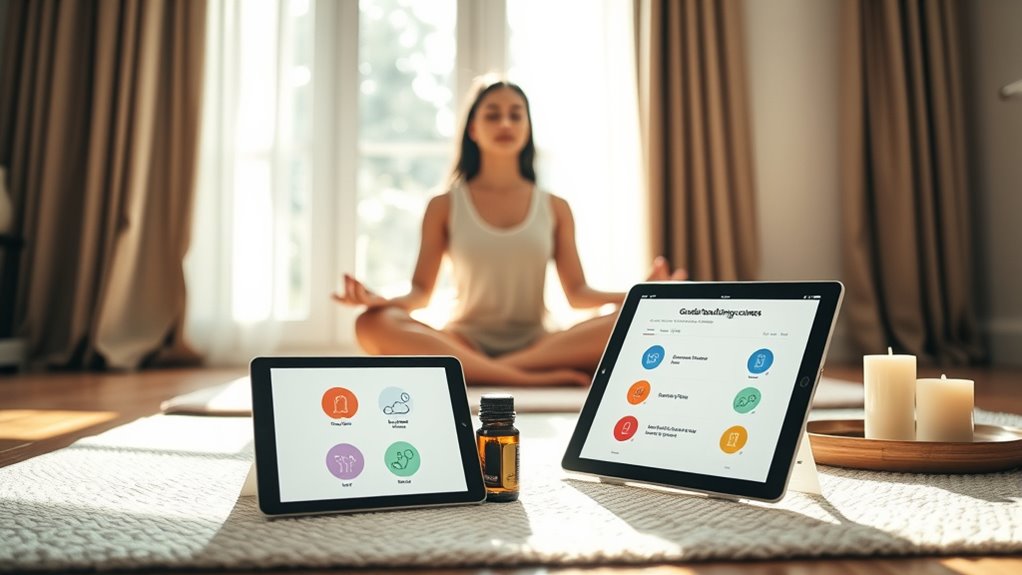
When comparing different breathing techniques, their ease of use and accessibility often determine how likely you are to incorporate them into your daily routine. Mindfulness apps make guided breathing exercises simple and convenient, allowing you to practice anytime without special equipment. They often feature step-by-step instructions, timers, and progress tracking, making consistency easier. Breathing gadgets, like handheld devices or wearables, can also enhance accessibility by providing real-time feedback and structured exercises. However, these may require purchasing and setup, which could be a barrier for some. In contrast, basic techniques like deep breathing or diaphragmatic breathing need no tools, making them highly accessible. Ultimately, your choice depends on how easily you can integrate these methods into your lifestyle and comfort with technology.
Effectiveness and Long-Term Benefits of Each Approach
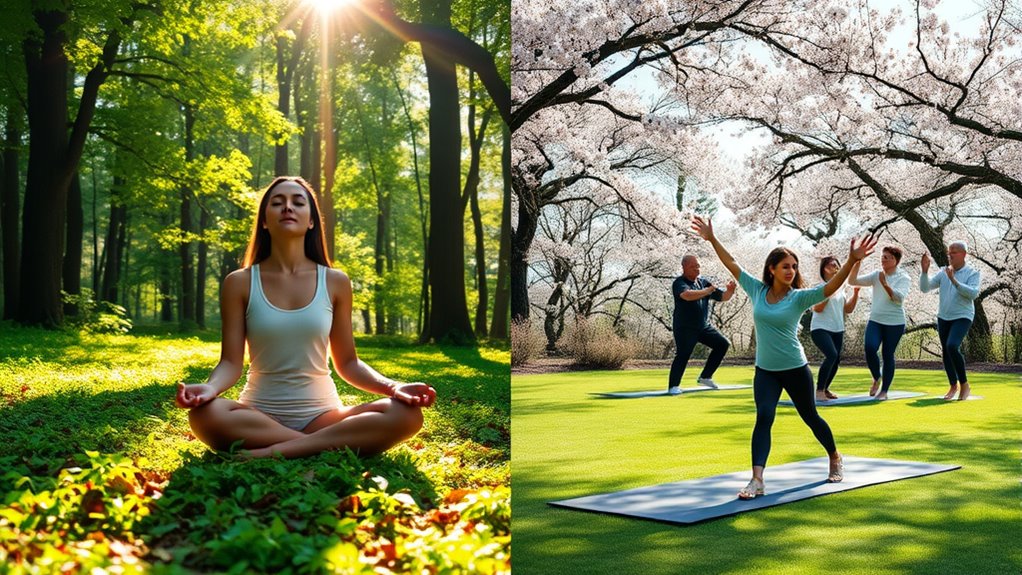
Different breathing techniques vary in their effectiveness and long-term benefits, depending on how consistently and correctly you practice them. When done regularly, breathing exercises can enhance your mindful eating, helping you become more present and aware of your body’s signals. They also complement aromatherapy benefits by deepening relaxation and reducing stress. Consider these outcomes:
- You develop a calmer mind, making daily challenges easier to handle.
- You strengthen emotional resilience, preventing burnout.
- You cultivate mindfulness, improving your overall well-being.
- You create a lasting sense of balance that extends beyond moments of stress.
While breathing exercises offer immediate relief, sustained practice access long-term mental clarity. Pairing them with mindful eating and aromatherapy can amplify their benefits, leading to a healthier, more centered you.
Choosing the Right Stress-Relief Strategy for Your Lifestyle
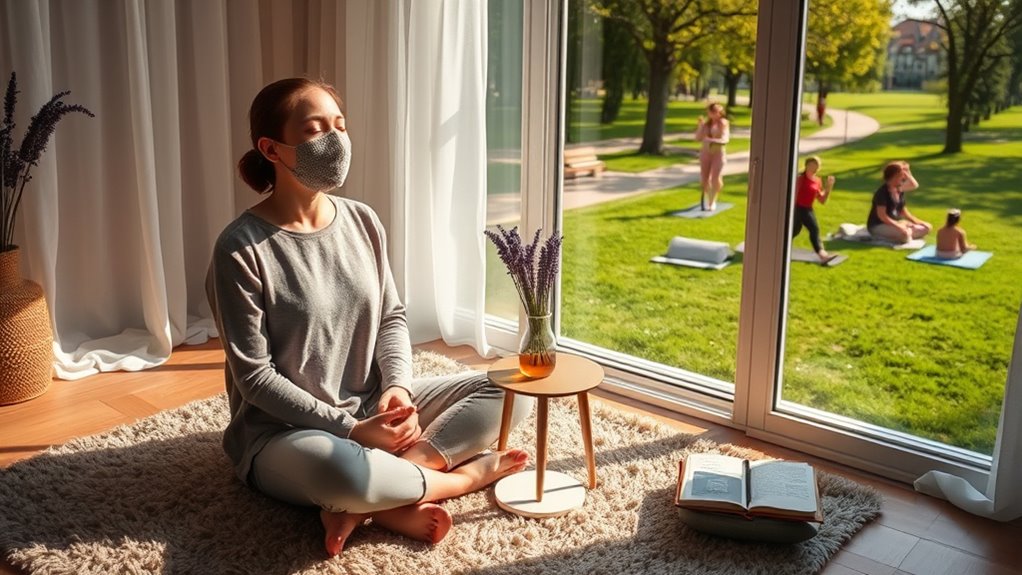
Choosing the right stress-relief strategy depends on your daily routine, preferences, and lifestyle commitments. If you have a busy schedule, quick methods like breathing exercises can trigger your relaxation response, reducing stress hormones rapidly. On the other hand, if you prefer outdoor activities, walking or yoga might better fit your lifestyle, helping you manage stress hormones over time. Consider what feels sustainable and enjoyable, as consistency is key to lowering stress. Some strategies, like meditation, foster a lasting relaxation response, while others, like physical activity, provide immediate relief. By aligning your chosen method with your habits, you’ll be more likely to stick with it and experience genuine stress reduction. The best approach is one that integrates seamlessly into your life, promoting ongoing balance.
Frequently Asked Questions
Can Breathing Techniques Replace Professional Therapy for Chronic Stress?
Breathing techniques alone can’t replace professional therapy for chronic stress. They can help you manage immediate feelings of anxiety and promote relaxation, but therapy offers personalized guidance, coping strategies, and address underlying issues. Incorporate mindfulness meditation and physical activity to enhance your stress management. Combining these methods with professional support gives you a thorough approach, making it more effective than relying solely on breathing exercises.
Are There Specific Breathing Methods Suited for Different Age Groups?
You can choose age-specific breathing techniques tailored for different age groups. For children, child-friendly techniques like deep belly breaths or blowing bubbles help them relax and focus. Adults might prefer diaphragmatic breathing or box breathing for stress relief. Older adults benefit from gentle, slow-paced breathing exercises that accommodate physical limitations. Adapting your approach guarantees the method is effective and comfortable, making it easier to incorporate into daily routines.
How Quickly Can I Expect to See Stress Reduction Results?
You can often notice stress reduction within minutes of practicing mindfulness meditation or doing yoga stretches. Consistent practice enhances these effects over time, making you feel calmer and more centered. Incorporate these techniques into your daily routine, and you’ll likely see quicker results, especially when combined with mindful breathing exercises. Remember, patience and regularity are key to experiencing the full benefits of stress-relief methods.
What Are Common Mistakes to Avoid With Breathing Exercises?
You should avoid common mistakes like rushing your breath or forcing it, as this can hinder relaxation. Focus on maintaining mindful awareness of your breath and guarantee proper technique, such as deep, steady inhalations and exhalations. Don’t hold your breath too long or become distracted; stay present. These practices help maximize benefits, reduce stress effectively, and prevent frustration or discomfort during your breathing exercises.
Is There Scientific Evidence Supporting Alternative Stress Relief Methods?
Scientific studies show that mindfulness meditation and physical activity can considerably reduce stress levels, with some research indicating up to a 30% decrease in cortisol. Alternative evidence suggests these methods are effective complements or even substitutes for breathing exercises. You don’t have to rely solely on breathing; exploring these options might better suit your preferences, and the scientific support behind them makes trying them a worthwhile step toward managing stress.
Conclusion
Choosing the right stress relief method can feel like picking a superhero for your mental health team. Whether you breathe deeply, dance wildly, or talk to a pro, you’re activating superpowers that can save your day. Don’t underestimate the power of just one small change—your stress might just vanish faster than your favorite snacks disappear. So go ahead, pick your hero, and watch stress cower in the corner like a scared kitten!









